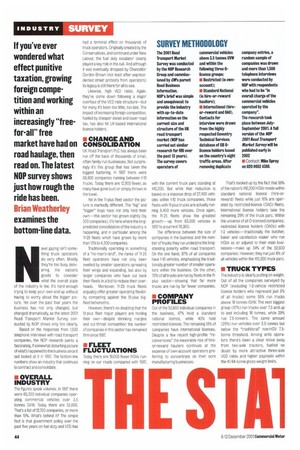If you've ever wondered what effect punitive taxation, growing foreign competition and working within an increasingly "freefor-all" free
Page 44

If you've noticed an error in this article please click here to report it so we can fix it.
market have had on road haulage, then read on. The latest NOP survey shows just how rough the ride has been.
Brian Weatherley examines the bottom-line data.
Navel gazing isn't something truck operators do very often. Mostly they're too busy deliv
ering the nation's goods to consider what the overall state of the Industry is Like. It's hard enough trying to keep your own end up without having to worry about the bigger picture. Yet over the past four years the business has not only changed, but changed dramatically, as the latest 2001 Road Transport Market Survey conducted by NOP shows only too clearly.
Based on the responses from 1,500 telephone interviews wKh road transport companies, the NOP research paints a fascinating, if somewhat disturbing picture of what's happened to the business since it last looked at it in 1997. The bottom-line numbers show an industry that continues to contract and consolidate.
• OVERALL INDUSTRY
The figures speak volumes. In 1997 there were 65,300 individual companies operating commercial vehicles over 3.5 tonnes GVW. Today there are 52,600. That's a fall of 12,700 companies, or more than 19%. What's behind it? The simple fact is that government policy over the past five years on fuel duty and VED has had a terminal effect on thousands of truck operators. Originally created by the Conservatives, and continued under New Labour, the fuel duty escalator clearly played a key role in the cull. And although K was eventually dropped by Chancellor Gordon Brown (not least after unprecedented street protests from operators) its legacy is still there for all to see.
Likewise, high VED rates. Again, they've come down following a major overhaul of the VED rate structure—but for many it's been too little, too late. The impact of increasing foreign competition, fuelled by cheaper diesel and lower road tax, has also hit UK-based international licence holders.
CHANCE AND CONSOLIDATION
UK Road Transport PLC has always been run off the back of thousands of small, Often family-run businesses. Not surprisingly it's this group that has taken the biggest battering. In 1997 there were 58,000 companies running between 1-10 trucks. Today there are 12,900 fewer, as many have gone bust or simply thrown in the towel.
Yet in the 11-plus fleet sector the picture is markedly different. The "big" and "bigger" boys have not only held their own—this sector has grown slightly (by 200 companies). It's here where the longpredicted consolidation of the industry is happening, and in particular among the 11-25 fleets which have grown by more than 10% to 4,300 companies.
Traditionally operating in something of a 'no-man's-land", the ranks of 11-25 fleet operators have not only been swelled by smaller operators spreading their wings and expanding, but also by larger companies who have cut back their fleets in a bid to reduce their overheads. Moreover, 11-25 truck fleets arguably offer greater operating flexibility competing against the 51-plus bigfleet behemoths.
However, there's no doubting that the 51-plus fleet major players are holding their own—despite shrinking margins and cut-throat competition the number of companies in this sector has remained firm since 1997.
IP FLEET
FLUCTUATIONS
Today there are 19,000 fewer HGVs running on our roads compared with 1997,
with the current truck pare standing at 410,200. But while that reduction is based on a massive drop of 27,400 vehicles within 1-10 truck companies, those fleets with 11-plus trucks are actually running 8,400 more vehicles. Once again, the 11-25 fleets show the greatest growth—up from 63,000 vehicles in 1997 to a current 76,900.
The difference between the size of companies in the business and the number of trucks they run underpins the longstanding polarity within road transport. On the one hand, 87% of all companies have 1-10 vehicles, emphasising the traditionally greater number of smaller operators within the business. On the other, 70% of all trucks are run by fleets in the 11plus sector—showing that far more trucks are run by far fewer companies.
• COMPANY PROFILES
Out of the 52,600 individual companies in the business, 47% hold a standard national licence, while 40% hold restricted licences. The remaining 13% of companies have international licences. Despite a few recent high-profile "reconversions" the inexorable rise of hireor-reward hauliers continues at the expense of own-account operators preferring to concentrate on their care manufacturing businesses.
That's backed up by the fact that 55% of the nation's 410,200 HGVs reside within standard national licence (hire-orreward) fleets while just 16% are operated by restricted-licence (040) fleets. International licence holders take the remaining 29% of the truck parc. Within the universe of all 0-licensed companies, restricted licence holders (0A0s) wrth 1-2 vehicles--traditionally the butcher, baker and candlestick maker who run HGVs as an adjunct to their main businesses—make up 34% of the 52,600 companies. However, they run just 6% of all vehicles within the 410,200 truck para.
• TRUCK TYPES
The industry is clearly putting on weight. Out of all the companies surveyed by NOP (excluding 1-2-vehicle restricted licence holders who represent just 6% of all trucks) some 55% run trucks above 18 tonnes GVW. The next biggest group (47%) run trucks over 7.5 and up to and including 18 tonnes, while 29% run 7.5-tonners. The same amount (29%) run vehicles over 3.5 tonnes but below the "traditional" non-HGV 7.5tonne threshold. Among artic operators there's been a clear move away from two-axle tractors, fuelled no doubt by more attractive three-axle VED rates and higher payloads within the 41/44-tonne gross weight limits.
























































































































































